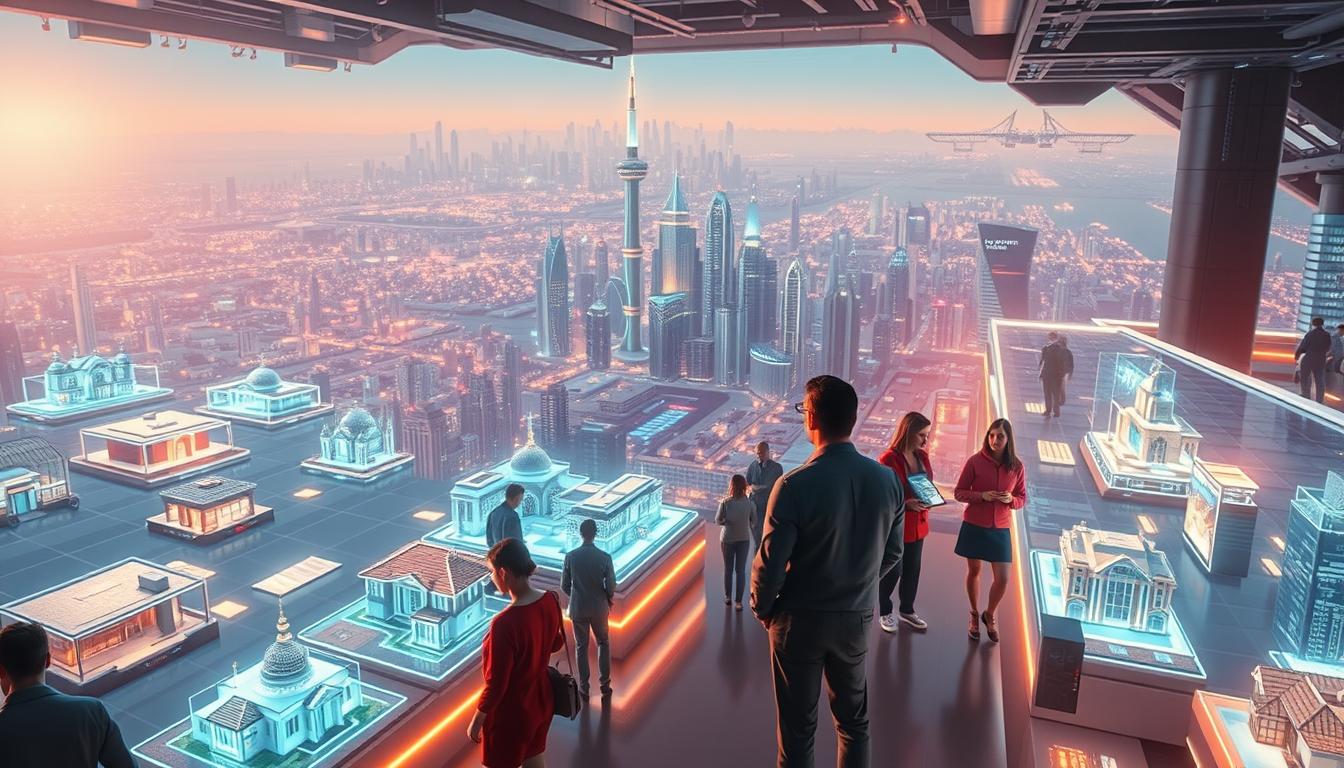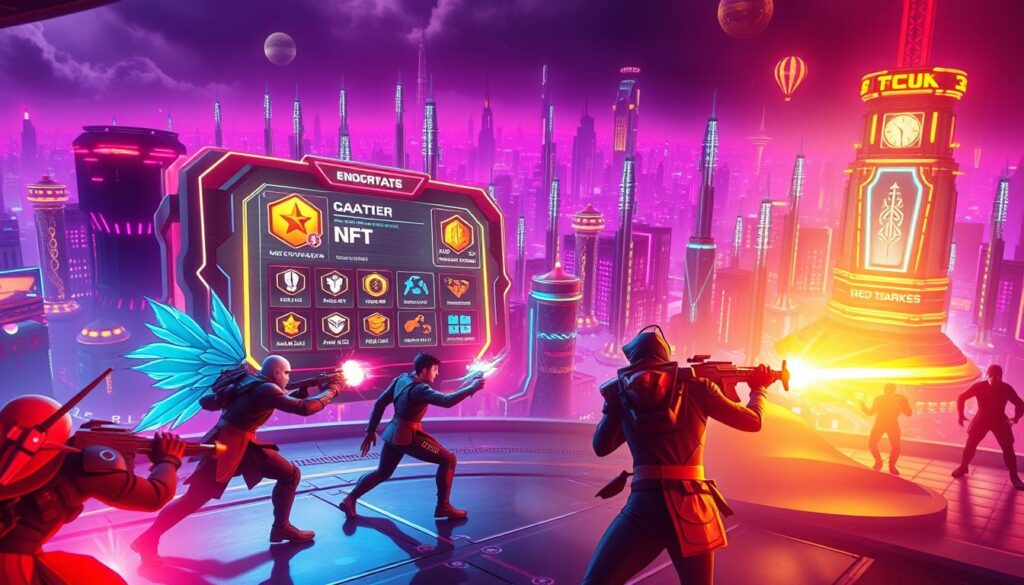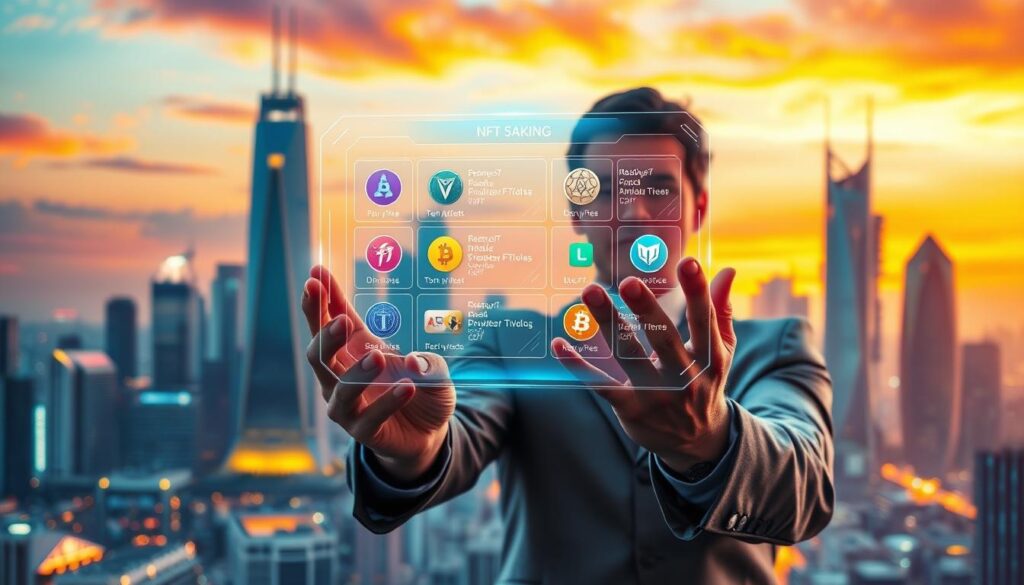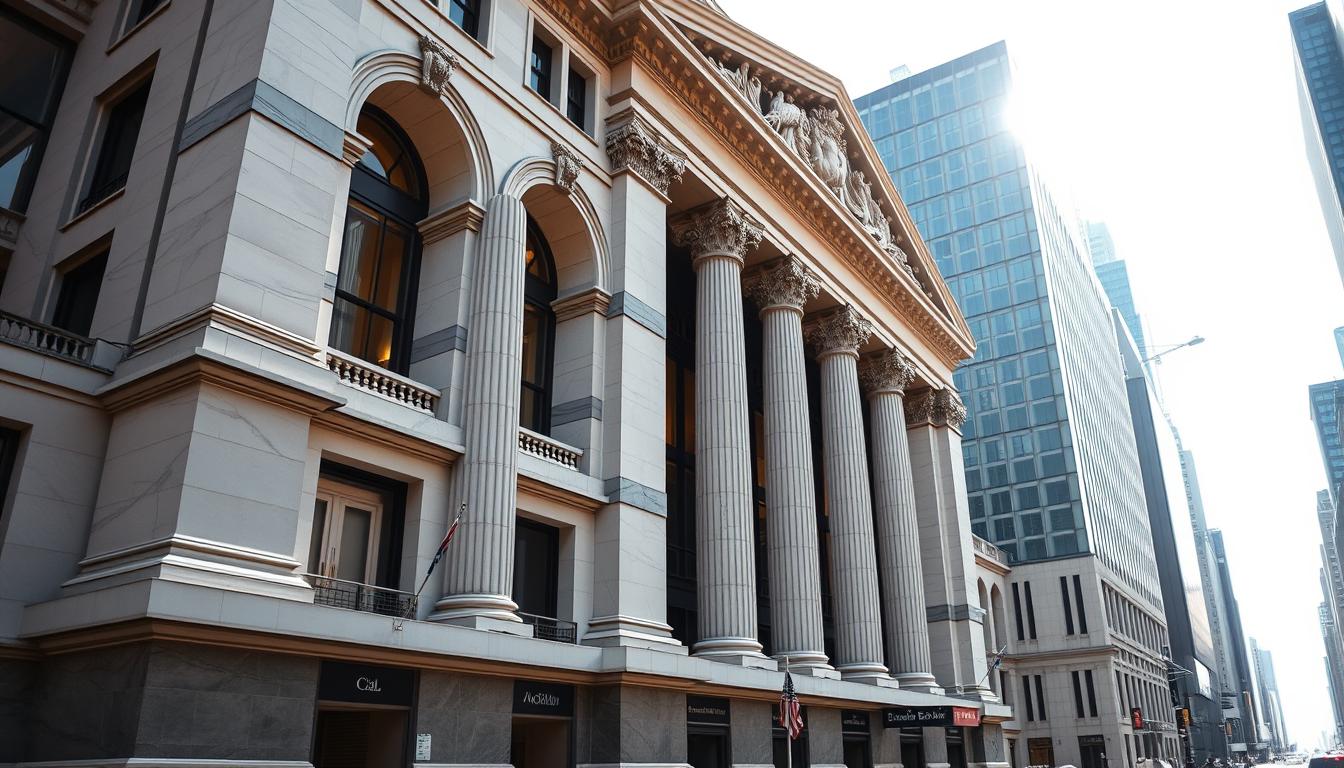Now Reading: NFT Virtual Real Estate: Trends and Insights
- 01
NFT Virtual Real Estate: Trends and Insights
NFT Virtual Real Estate: Trends and Insights
Blockchain technology is reshaping how we define ownership, merging physical and digital spaces through unique digital titles. These blockchain-based tokens now represent properties in immersive online environments, creating markets where users trade parcels of land, buildings, and even entire neighborhoods. Major financial institutions like JPMorgan Chase predict this emerging economy could reach $1 trillion, signaling a seismic shift in global investment strategies.

Platforms such as Decentraland and The Sandbox have become hotspots for innovation, offering tools to build, monetize, and interact with digital spaces. Unlike traditional property markets, these ecosystems enable fractional ownership models and instant transactions through smart contracts. The fusion of gaming, social experiences, and commerce within these worlds challenges conventional ideas about value creation.
This evolution extends beyond purely digital assets. Some projects tokenize physical buildings, allowing multiple investors to hold shares in real-world structures. As boundaries between tangible and intangible assets blur, both individual buyers and institutional players are exploring how blockchain can streamline processes like title transfers and lease agreements.
Key Takeaways
- Blockchain-based tokens enable verifiable ownership of digital and physical properties
- Leading metaverse platforms host active real estate markets with unique economic models
- Financial analysts project trillion-dollar opportunities in decentralized property ecosystems
- Tokenization allows fractional investment in high-value assets across geographical boundaries
- Hybrid models bridge traditional real estate practices with Web3 innovations
Understanding NFT Virtual Real Estate
Blockchain introduces a new paradigm for verifying and transferring asset ownership digitally. These systems use unique cryptographic certificates to represent physical or virtual properties, enabling transparent transactions across borders. Unlike traditional methods, this approach eliminates intermediaries while maintaining secure, permanent records.
How Cryptographic Certificates Work
Non-fungible tokens act as tamper-proof deeds stored on distributed ledgers. Each token contains specific details about a property’s location, size, and ownership history. This system reduces disputes by providing a single source of truth accessible to all parties.
Whole Assets vs Shared Stakes
Two models dominate tokenized property markets:
- Complete asset conversion: Turns entire properties into single tokens (rare due to legal complexities)
- Fractional shares: Splits ownership into tradeable portions, similar to stock market investments
Shared stake models gain traction because they mirror regulated securities frameworks. Corporations can tokenize buildings through SEC-registered shares, letting multiple investors profit from rental income or appreciation. This approach avoids the regulatory hurdles of converting full property deeds into standalone tokens.
The Rise of Digital and Virtual Worlds
Immersive environments are redefining how people interact, blending creativity with commerce in interconnected spaces. These worlds combine gaming mechanics with social ecosystems, creating dynamic markets where users build, trade, and monetize digital assets. Over 400 million active monthly users now engage across leading platforms, transforming entertainment and business landscapes.

Exploring the Metaverse and Sandbox Platforms
Decentraland and The Sandbox lead with user-driven economies where participants own and develop parcels. Roblox attracts younger audiences through customizable experiences, while Somnium Space focuses on VR-compatible environments. Key features distinguishing these platforms:
- Persistent 3D worlds with user-generated content tools
- Native cryptocurrencies for in-platform transactions
- Governance systems letting users vote on platform updates
Location matters here as much as in physical cities. Parcels near popular event spaces in Decentraland sell for premium prices. Brands like Gucci host virtual fashion shows, while Snoop Dogg’s Sandbox mansion draws thousands to exclusive concerts.
Revenue streams mirror traditional models but with Web3 twists. Users earn through:
- Renting developed spaces for events
- Selling branded digital merchandise
- Hosting paid gaming tournaments
Paris Hilton’s Roblox island demonstrates mainstream adoption, generating income through virtual meetups and merchandise sales. These ecosystems prove digital ownership can create tangible economic value beyond gaming.
How Blockchain is Revolutionizing Property Transactions
Traditional property deals often drown in paperwork and third-party delays. Blockchain technology flips this model by creating unchangeable digital records that track every sale, transfer, and legal action tied to an asset. This system lets buyers verify a property’s full history in seconds – no more digging through dusty archives or waiting weeks for title searches.
Secure, Transparent Ownership Records
Every transaction gets stamped into a blockchain ledger like permanent ink. You can see:
- Exact ownership timelines
- Past disputes or liens
- Payment histories
This transparency cuts fraud risks and speeds up deals. Smart contracts take it further by automating tasks that usually need lawyers or agents. For example:
- Rent payments trigger automatically on due dates
- Maintenance fees split evenly between co-owners
- Dividends distribute instantly to investors
Deals that took months now happen in minutes. Buyers skip the paperwork shuffle while sellers avoid costly intermediaries. As this technology matures, it’s reshaping how we think about trust in high-value exchanges.
NFTs in Physical Versus Digital Real Estate
Scarcity drives value in both physical spaces and digital domains, but how ownership works differs dramatically. While traditional markets rely on government-backed deeds, blockchain-based systems use cryptographic verification to establish rights. Platforms like Decentraland cap total available plots at 90,601, mirroring Earth’s limited land supply through code-enforced scarcity.

Differences Between Real and Digital Assets
Physical properties face layers of zoning laws and title insurance requirements. Converting homes into tokens requires navigating complex legal frameworks across jurisdictions. Digital parcels, however, operate under platform-specific rules that bypass traditional regulations. The first blockchain-based property transaction in 2017 – later re-auctioned through Propy – showed how physical asset tokenization faces hurdles digital spaces avoid.
Key distinctions include:
- Transfer speed: Physical deeds take weeks to process; digital ownership changes in minutes
- Modification rights: Building permits vs. platform development tools
- Geographical limits: Local markets vs. global 24/7 trading
Advantages of Digital Land Registration
Blockchain registration slashes administrative costs by eliminating notaries and paper records. Smart contracts automatically enforce parcel boundaries and usage terms. Users trade Decentraland’s LAND tokens using MANA cryptocurrency without bank approvals or credit checks.
Three core benefits stand out:
- Instant verification: Ownership history visible on public ledgers
- Fractional flexibility: Split high-value parcels into affordable shares
- Programmable utilities: Attach revenue streams like ad space rentals
Innovative Use Cases in the Real Estate Sector
The mortgage industry is undergoing a radical transformation through programmable ownership systems. Forward-thinking companies now embed financial agreements directly into blockchain-based assets, creating self-executing contracts that redefine lending practices.
NFT Mortgages and Automated Smart Contracts
LoanSnap’s Bacon Protocol demonstrates this shift by converting home equity loans into tradeable digital tokens. Instead of paper documents, borrowers receive blockchain certificates containing payment terms and ownership rights. These tokens automatically track repayments while enabling secondary market trading.
Three innovations stand out:
- Instant settlements: Transactions finalize in minutes instead of weeks
- Fractional investing: Planned bHome stablecoin lets multiple investors own parts of mortgage portfolios
- Auto-compliance: Smart contracts adjust payments based on interest rates or property values
Property management also benefits from automation. Digital agreements now handle rent collection, maintenance requests, and utility splits without manual oversight. For example, landlords can program tokens to release security deposits only after move-out inspections.
These systems create new revenue streams. Investors earn through automated dividend distributions, while platforms charge minimal fees compared to traditional services. As more companies adopt this model, they’re proving that code-driven solutions can add measurable value to age-old processes.
Trends and Key Statistics Shaping the Market
Digital property markets are exploding as mainstream adoption accelerates. JPMorgan Chase forecasts a $1-trillion valuation for the metaverse economy, while Gartner predicts 25% of people will spend an hour daily in these spaces by 2026. This growth fuels intense competition for prime locations across leading platforms.

Current Investment Models and Market Behavior
Decentraland exemplifies this boom with 50,000 daily users and its MANA cryptocurrency holding a $3.5-billion market cap. Premium parcels near event hubs regularly sell for six figures, with one plot listed above $1 million. Investors employ three primary strategies:
- Direct ownership: Acquiring full parcels purchased using cryptocurrency
- Fractional shares: Pooling funds through crypto-backed investments
- Development partnerships: Collaborating on commercial projects within platforms
Market patterns reveal location remains king. Prices near digital landmarks outpace remote areas by 300-500%. Younger demographics dominate purchases, with 68% of buyers under 35 according to recent platform data.
Speculation drives short-term trades, while institutions secure long-term holdings for brand activations. This dual approach creates volatile yet lucrative opportunities as the sector matures. With user bases expanding 40% quarterly, early adopters position themselves for potential windfalls.
Navigating Legal and Regulatory Challenges
Legal frameworks struggle to keep pace with blockchain innovation in property markets. Converting physical deeds into digital tokens faces significant compliance hurdles, particularly when attempting full asset transfers. Many jurisdictions still require paper-based documentation, creating friction for blockchain-based systems.
Compliance Issues in Tokenized Transactions
Entire asset tokenization requires rewriting century-old property laws. For example, transferring ownership through smart contracts lacks recognition in most U.S. states. Fractional models gain traction by aligning with existing securities rules, though they demand SEC oversight similar to stock offerings.
Three critical challenges emerge:
- Jurisdictional conflicts: Digital parcels often exist across multiple legal territories simultaneously
- Ownership disputes: Inheritance claims for blockchain-based assets remain untested in courts
- Tax implications: IRS guidelines for tokenized properties remain unclear
Major companies like Propy work with regulators to establish standardized practices. Their pilot programs in Colorado and Vermont demonstrate how hybrid systems could bridge traditional and digital systems. Until clearer frameworks emerge, investors must navigate this evolving landscape cautiously.
Future Prospects and Emerging Metaverse Platforms
The next frontier of digital interaction lies in evolving metaverse ecosystems where creativity meets commerce. Companies like General Motors and Estée Lauder now test immersive installations in virtual spaces, while fashion houses craft avatar clothing lines. These developments signal a shift toward blended environments merging physical and digital worlds.
Opportunities for Asset Development
Innovative ecosystems enable creators to build virtual spaces combining entertainment with commerce. Brands host live events in these digital environments, while personalized shopping experiences emerge in branded worlds. This evolution removes geographical barriers, letting businesses engage global audiences instantly.
Predicted Market Growth and Innovations
Meta’s $10-billion investment in VR infrastructure underscores the sector’s potential. Analysts anticipate tools reducing transaction costs like gas fees while enhancing cross-platform functionality. Hybrid experiences merging augmented reality with persistent digital environments will likely drive the next growth phase, shaping future economic landscapes.
FAQ
How do blockchain-based platforms ensure secure ownership of digital assets?
Blockchain technology creates tamper-proof, decentralized ledgers that track every transaction. Platforms like Ethereum and Solana use smart contracts to automate transfers, ensuring transparency and eliminating third-party risks. This system is used by OpenSea and Decentraland for verifying ownership.
What advantages do metaverse platforms offer over traditional property investments?
Platforms like The Sandbox and Somnium Space allow global access, 24/7 trading, and lower entry costs. Digital spaces can host events, ads, or games, generating passive income. Unlike physical locations, these environments aren’t limited by geography or zoning laws.
Can fractional ownership models apply to tokenized assets?
Yes. Projects like Boson Protocol divide parcels into smaller tokens, letting multiple investors share ownership. This approach reduces upfront costs and increases liquidity, similar to REITs but with blockchain’s speed and accessibility.
How do smart contracts simplify transactions in decentralized environments?
Automated agreements on networks like Polygon or Avalanche execute instantly when conditions are met. For example, a mortgage payment in Decentraland could auto-transfer ownership after final installment, cutting paperwork and delays.
What legal risks exist when buying land in virtual worlds?
Jurisdiction disputes and unclear tax rules are common. Platforms like Cryptovoxels operate globally, but users must research local regulations. Intellectual property rights for created content also vary by platform—always review terms of service.
Which emerging trends are driving growth in metaverse property markets?
Brands like Nike and Gucci lease digital storefronts, while concerts in Fortnite showcase revenue potential. Innovations like VR integration (via Oculus) and AI-driven customization tools are expanding usability, attracting investors and developers alike.
How does digital land registration differ from physical deeds?
Instead of county records, ownership is stored on-chain via non-fungible tokens (NFTs). Platforms like SuperWorld use geospatial tagging, while others like Upland tie virtual plots to real-world addresses. Transactions settle in minutes, not weeks.
Are gas fees a barrier to trading tokenized properties?
High Ethereum network costs have pushed projects to layer-2 solutions like Immutable X or sidechains. For instance, The Sandbox migrated to Polygon to reduce fees, making microtransactions feasible for smaller investors.














